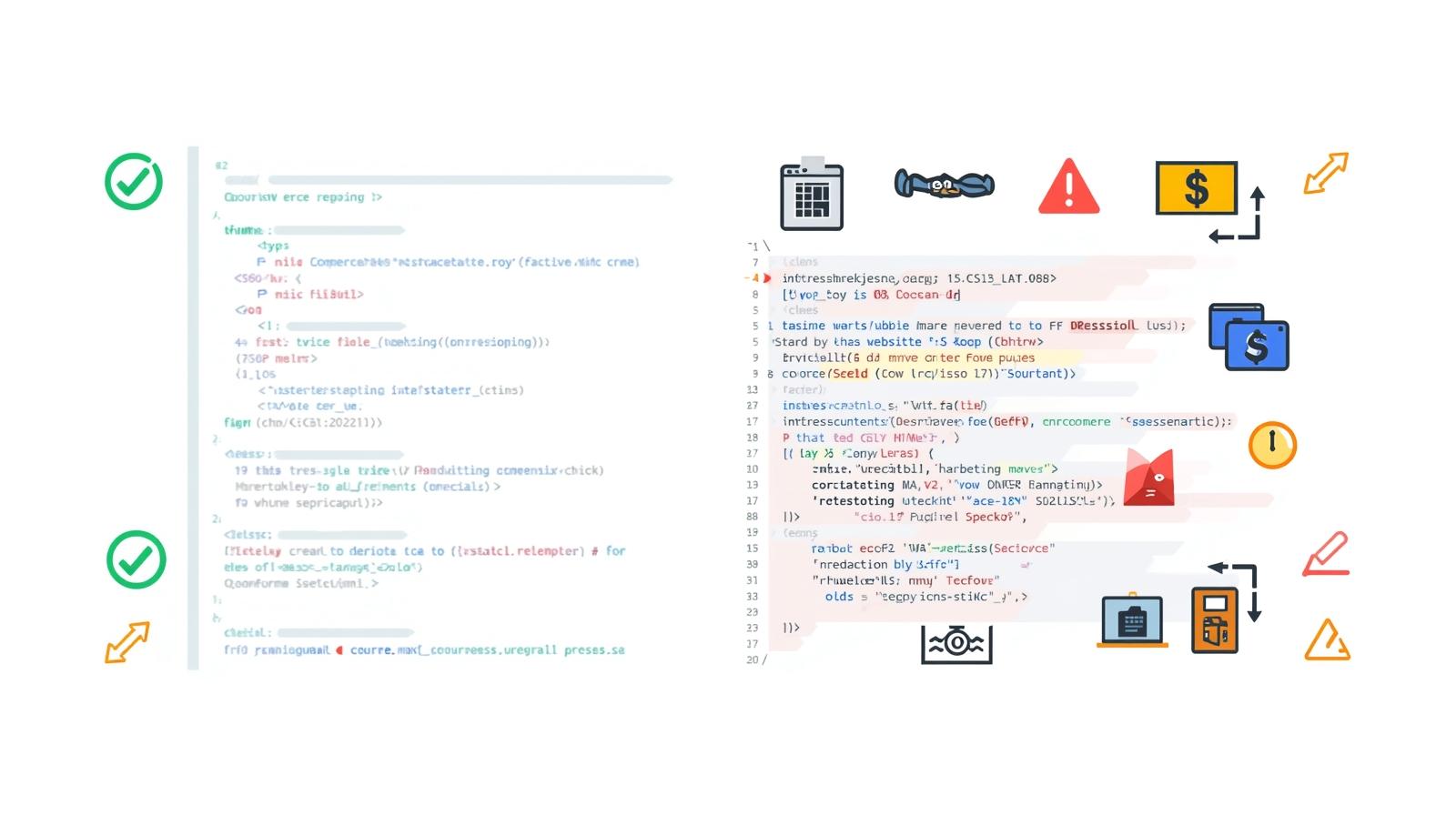When it comes to building a successful website, most people focus on eye-catching design and compelling content. While these elements are crucial, they can only take you so far. Without SEO-Friendly Code, even the most beautifully designed and well-written site may struggle to appear in search results.
SEO-friendly code refers to the clean, structured, and optimized HTML, CSS, and JavaScript that form the backbone of your website. It ensures that search engines can efficiently crawl, index, and understand your content.
In modern web development, this type of coding is not just a technical best practice—it’s a fundamental requirement for visibility and growth online.
Well-structured code enhances more than just rankings. It directly improves website optimization, leading to faster load speeds, smoother navigation, and an overall better user experience (UX). When your site is both search-engine and user-friendly, it’s far more likely to convert visitors into loyal customers.
In short, design and content may capture attention, but SEO for websites begins at the code level—making SEO-friendly code the foundation of a high-performing digital presence.
What is SEO-Friendly Code?
At its core, SEO-friendly code is the practice of writing and structuring a website’s code in a way that makes it easy for search engines to crawl, interpret, and index content.
Unlike messy or bloated code, which can confuse crawlers and slow down performance, clean code SEO ensures that every line contributes to better visibility and smoother functionality.
So how does it differ from standard code? While standard code may simply “work” to display a website, it doesn’t necessarily follow best practices for optimized HTML or user experience.
For example, a site may look fine on the front end but contain redundant scripts, missing alt attributes, or poorly nested tags in the backend. These issues don’t just affect search rankings—they can also frustrate users with slow load times or broken elements.
Search engines like Google rely heavily on search engine-friendly code to understand a site’s purpose and relevance. Features such as semantic HTML tags, properly structured headings, descriptive attributes, and minimal unnecessary code make a huge difference in crawlability and indexability.
In simple terms, when your code is clean and optimized, search engines can find, analyze, and rank your site faster and more accurately.
Well-crafted code is therefore more than a technical detail—it’s the invisible foundation of strong SEO performance.

Why SEO-Friendly Code is Important
The speed. Websites with bloated or poorly written code often load slowly, which frustrates users and signals to Google that the site isn’t providing a great experience.
On the other hand, lean, well-structured code improves website performance SEO, helping pages load quickly across devices and internet speeds.
Another critical benefit is user experience. SEO-friendly code supports accessibility features, mobile responsiveness, and clean navigation—all of which make your site more usable for visitors.
When people find it easy to browse your site, they’re more likely to stay longer, engage with your content, and convert into customers.
Finally, optimized code ensures better compatibility across different browsers and devices. Whether someone visits your site on Chrome, Safari, or a mobile browser, well-written code guarantees that the layout and functionality remain consistent.
This reliability builds trust with users and gives search engines additional signals that your website deserves higher placement.
In short, SEO-friendly code is important because it strengthens every aspect of your site—from rankings and speed to usability and long-term performance.
Core Elements of SEO-Friendly Code
Building a website with SEO-friendly code requires attention to detail across multiple areas. From the way you structure your HTML to how you optimize metadata, every element plays a role in helping search engines and users get the best possible experience. Below are the most important components of clean, search engine-friendly code.
1. Clean and Organized HTML Structure
A solid foundation begins with semantic HTML SEO. Using semantic tags like <header>, <section>, <article>, and <footer> helps search engines understand the context and hierarchy of your content.
Pair this with a proper heading structure—using one <h1> per page, followed by <h2> and <h3> for subsections—to make your content scannable for both users and crawlers.
2. Optimized Meta Tags
Meta tags SEO plays a crucial role in click-through rates and rankings. Well-written meta titles should include your primary keywords naturally while remaining concise (50–60 characters). Meanwhile, meta descriptions should provide a compelling summary of the page in 150–160 characters, encouraging users to click from search results.
3. Image Optimization with Alt Text
Images are powerful for engagement but can weigh down performance if not handled correctly. Alt text optimization ensures that images are both accessible to screen readers and indexable by search engines.
Best practice is to write descriptive alt text that explains the image’s role without keyword stuffing—this improves accessibility and provides context for Google’s image search.
4. Proper Use of Schema Markup
Structured data SEO (schema markup) enhances how your website appears in search results. By marking up elements like reviews, events, FAQs, or products, you can earn rich snippets—boosting visibility and increasing click-through rates. Schema essentially translates your site’s information into a language search engines understand more clearly.
5. Minimized Code Bloat
Excessive inline styles, unused CSS, and unnecessary scripts slow down your website. Code optimization means reducing bloat by keeping your CSS and JavaScript clean, externalized, and lightweight. This improves loading speed, user experience, and ultimately your rankings.
When implemented together, these elements create a strong framework for SEO-friendly code, balancing technical precision with usability to maximize both performance and visibility.
Looking to build a website that’s not only visually stunning but also optimized for SEO from the ground up? Our WordPress development services combine clean, SEO-friendly code with modern design to give your business a competitive edge.

SEO-Friendly Code vs. Poorly Optimized Code
Not all code is created equal. While SEO-friendly code creates a strong foundation for visibility and performance, poorly optimized code can hold your website back in search rankings. Let’s compare the two to see the difference.
Comparison: Optimized vs. Non-Optimized Code
Not all code is created equal. While SEO-friendly code creates a strong foundation for visibility and performance, poorly optimized code can hold your website back in search rankings. Here’s how they differ:
-
HTML Structure
-
✅ SEO-Friendly Code: Uses semantic HTML tags like
<header>,<section>,<article>, making content structure clear. -
❌ Poorly Optimized Code: Relies on
<div>for everything, making it difficult for search engines to interpret.
-
-
Headings
-
✅ SEO-Friendly Code: Follows a proper hierarchy (one
<h1>per page, followed by<h2>,<h3>). -
❌ Poorly Optimized Code: Multiple
<h1>tags or headings out of order, confusing crawlers.
-
-
Meta Tags
-
✅ SEO-Friendly Code: Includes unique, optimized meta titles and descriptions.
-
❌ Poorly Optimized Code: Missing, duplicated, or poorly written meta tags.
-
-
Images
-
✅ SEO-Friendly Code: Uses descriptive alt text for accessibility and SEO.
-
❌ Poorly Optimized Code: Missing alt text or keyword-stuffed alt attributes.
-
-
CSS & JavaScript
-
✅ SEO-Friendly Code: Uses lightweight, minimized CSS and JS.
-
❌ Poorly Optimized Code: Bloated code with excessive inline styles and unused scripts.
-
-
Schema Markup
-
✅ SEO-Friendly Code: Implements structured data (schema) for rich results.
-
❌ Poorly Optimized Code: Lacks schema, making content harder to interpret.
-
-
Performance
-
✅ SEO-Friendly Code: Fast-loading, mobile-friendly, responsive across devices.
-
❌ Poorly Optimized Code: Slow load times and poor responsiveness.
-
Common Coding Mistakes That Hurt SEO
Even experienced developers can make mistakes that negatively impact SEO. Some of the most common issues include:
-
Duplicate or missing meta tags: Confuses search engines and reduces click-through rates.
-
Overusing inline styling: Leads to bloated code and slower page load speeds.
-
Missing alt text on images: Makes your site less accessible and limits SEO opportunities.
-
Using non-semantic HTML: Reduces crawlability and prevents search engines from understanding content hierarchy.
-
Excessive JavaScript reliance: Can block crawlers if not implemented properly, leaving key content invisible.
In short, optimized code helps both users and search engines, while poorly optimized code introduces barriers that can hurt rankings, performance, and overall experience.

Best Practices for Writing SEO-Friendly Code
Creating SEO-friendly code isn’t just about avoiding mistakes—it’s about following consistent best practices that improve performance, accessibility, and search visibility. Below are some proven approaches every developer and website owner should apply.
1. Prioritize Mobile-First Coding
Google has shifted to mobile-first indexing, which means your site’s mobile version is the primary reference for rankings. If your code doesn’t support responsive design, you risk losing visibility.
-
Use flexible layouts that adapt across devices.
-
Test for mobile responsiveness with tools like Google’s Mobile-Friendly Test.
-
Implement fluid grids, scalable images, and responsive typography.
Tip: Always design for mobile first, then scale up to larger devices. This ensures mobile-first SEO is at the core of your site.
2. Improving Site Speed with SEO-Friendly Code Optimization
Search engines (and users) prefer fast websites. Optimizing your code directly impacts site speed, which is a ranking factor.
-
Minify CSS, JavaScript, and HTML to remove unnecessary spaces, comments, and characters.
-
Use lazy loading so images and videos only load when needed.
-
Defer non-essential JavaScript to reduce render-blocking.
When implemented correctly, site speed optimization code improves both performance and SEO rankings.
3. Accessibility and Usability in Coding
Good SEO is also about creating a site that’s usable for all visitors, including people with disabilities. Search engines reward sites that prioritize accessibility.
-
Add ARIA labels to clarify interactive elements.
-
Use descriptive alt text for images (helpful for screen readers and SEO).
-
Build clear link structures with descriptive anchor text instead of generic “click here.”
This improves not only inclusivity but also overall user experience.
4. Regularly Audit and Validate Code
Even well-coded websites can develop issues over time. Routine audits help catch errors before they impact rankings.
-
Run audits with Lighthouse and W3C Validator.
-
Monitor crawl issues in Google Search Console.
-
Fix broken links, duplicate tags, and accessibility errors promptly.
By staying proactive, you ensure your website continues following SEO coding best practices.

Conclusion
The benefits of SEO-friendly code go beyond just visibility in Google. Optimized code leads to faster websites, smoother user experiences, and better accessibility across all devices. It ensures your site is easy for search engines to crawl, index, and rank—giving you an edge over competitors who neglect website code optimization.
For businesses serious about growth, auditing and refining code should be a regular part of their SEO strategy. The investment pays off in the form of higher rankings, increased traffic, and stronger user engagement.
Action step: Take time to review your site’s structure, meta tags, alt text, and loading speed. By embracing SEO-friendly code benefits, you not only strengthen your site’s performance today but also future-proof it for continued online success. If you’re unsure where to start, consider running a free SEO audit or consulting with a developer who specializes in website code optimization


